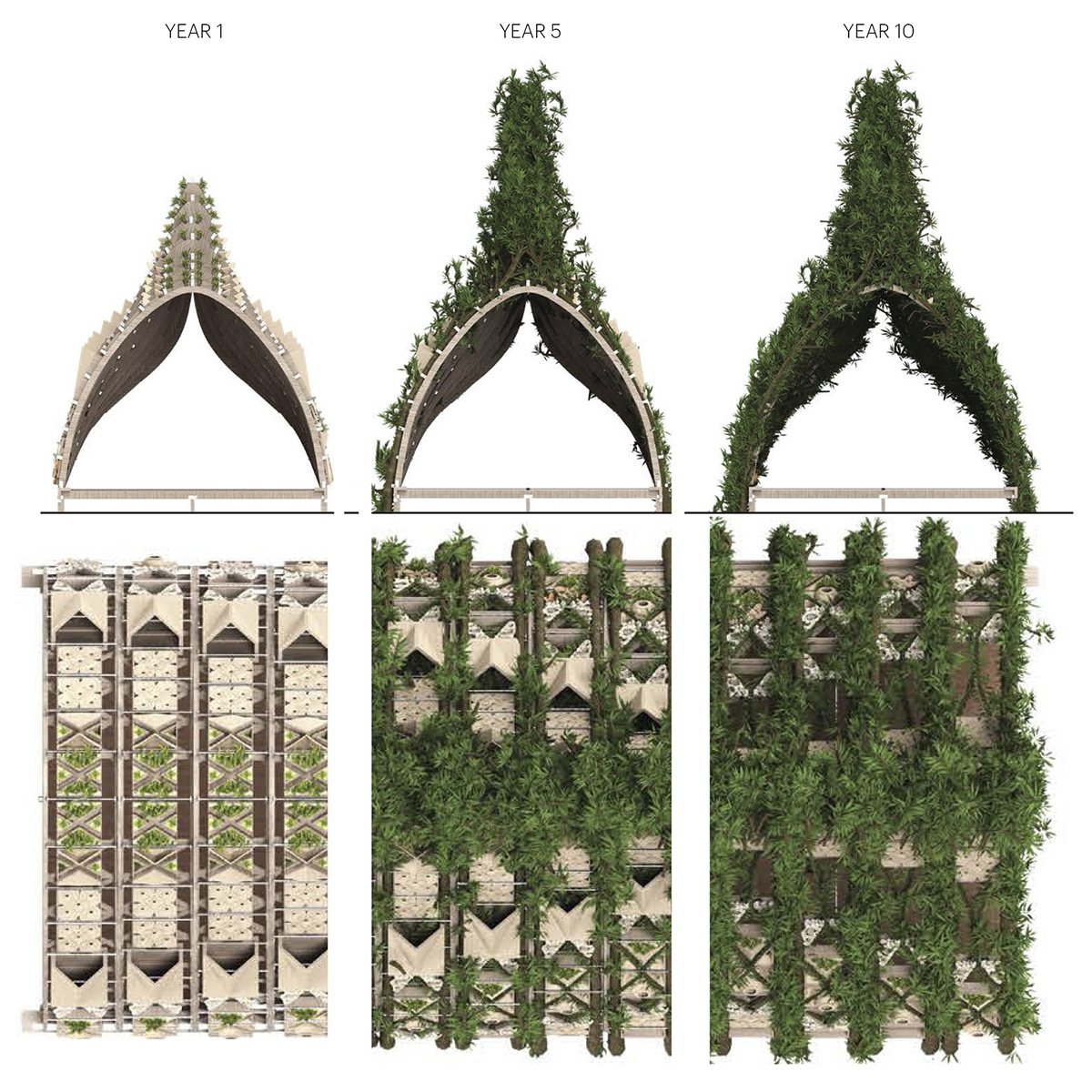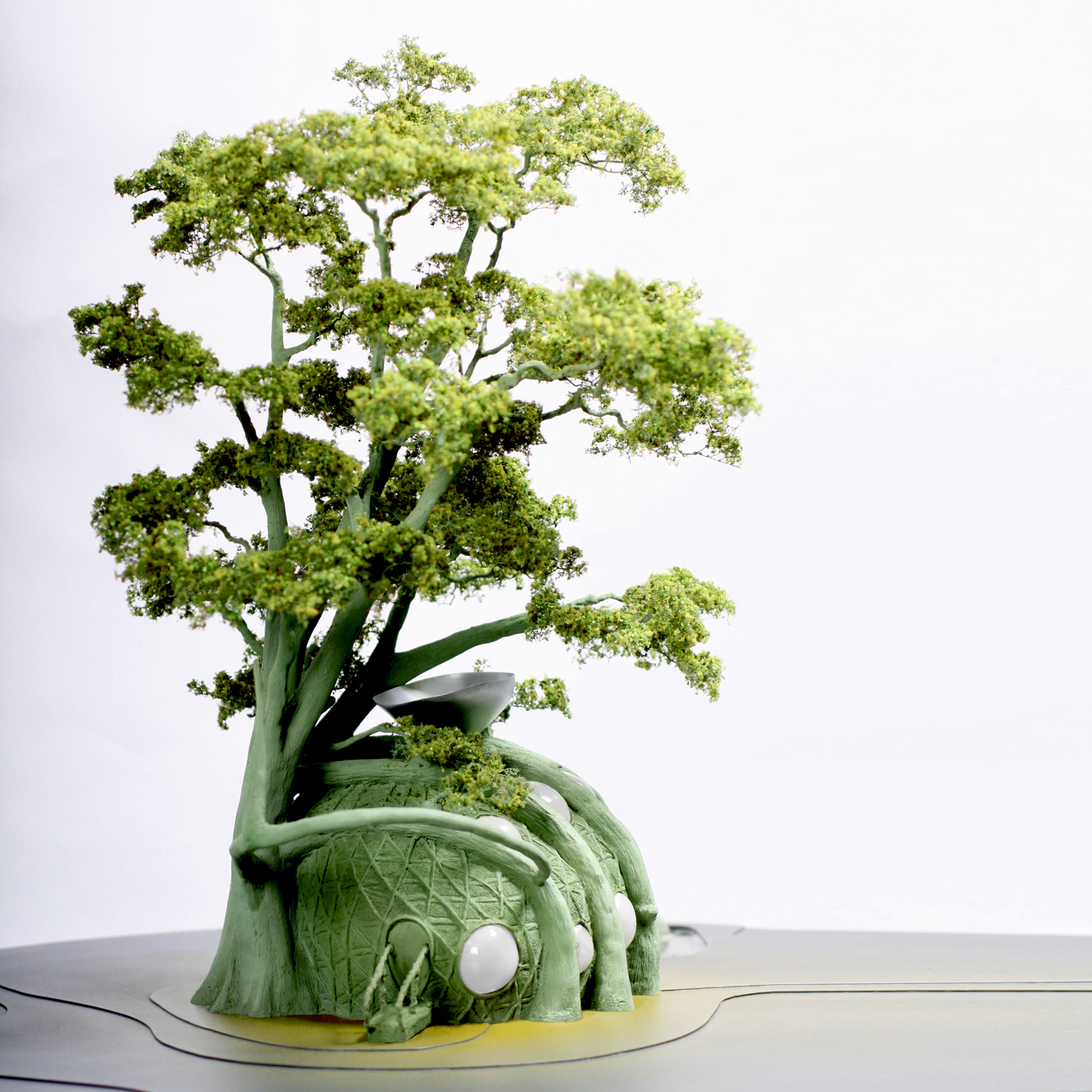Fab Tree Hab
MULTISPECIES LIVING STRUCTURE
VIDEO: Fab Tree Hab - Alive Architecture
“Protect, restore and promote sustainable use of terrestrial ecosystems […], and halt biodiversity loss.” - United Nations, Sustainable Development Goal #15 Life on Land
The first of its kind, the Fab Tree Hab is a terrestrial reef and grafted living tree structure. Shared by people and animals, this multispecies habitat combines indigenous tree-grafting techniques with computationally designed cross-laminated timber (CLT) arch scaffolds. The goal is to create a prototype dwelling that increases biodiversity by blending seamlessly into its natural surroundings while replacing harmful industrial materials with durable, bio-based alternatives. Foundation elements use almost no concrete on a platform of reclaimed dimensional lumber and all of the facade elements are either cedar or jute treated with beeswax and pine rosin to prevent decay. In every respect, this project generates life and minimizes carbon footprint, pushing the boundaries of regenerative design. The objective is to begin with agroforestry techniques and gradually evolve toward the creation of living structures composed of woody plants, a practice known as arbortecture.
Sourced from a local renewable energy biomass farm, thirty-foot-tall tree clusters are shaped on-site within large reusable timber scaffolds. After a year’s growth, the trees support the modular multispecies wall system. Wall components are made from a combination of handmade crocheted jute fiber volumes and 3D-printed bioplastic nodes. These serve as micro-habitats and food webs for flora and fauna to greatly enhance biodiversity. The structure takes a socio-ecological approach to architecture, serving as an observatory and education center for people and providing a wildlife refuge. The 1000 sq. ft. community-based project is located in New Windsor, New York, near Storm King Art Center.
Our nonprofit’s mission is to design against extinction. Our primary client is the site’s fecund flora and fauna. The project is an experiment towards a non-anthropocentric architectural paradigm based on co-creation with the environment. Another client is the general public, many of whom feel alienated from natural phenomena. We intend for our visitors to forest bathe, visualizing themselves as directly linked to the ecosystem. The challenge was to engage the public’s perspective about the possibilities of architecture to augment biodiversity. Similarly to Thoreau's Cabin and Laugier’s Primitive Hut, the project strives to revive the untamed and deliberate relationship to nature that humanity once sustained.
Community members and students are invited to track the structure’s evolution from its nascent form into a composite treehouse. The desired impact is to promote construction that works with, rather than in opposition to, the Earth’s metabolism. Fab Tree Hab started with a team of doctoral researchers at MIT and is now a fully developed experimental artifact. With the recognition that design is an iterative, refinable process, the team has learned to attune themselves to the gradual tempo of organic growth, to anticipate the unanticipated, and to engage with the environment with a newfound reverence for its independent agency. The impact transcends its ambitions having evolved into an educational receptacle that underscores listening to and learning from the natural world.
The Fab Tree Hab is an extension of its surrounding ecosystem, a habitat made from native willow trees that play host to humans and nonhumans. As dynamic as a forest, the structure is an embodiment of living matter, upending human-centered and energy-intensive construction practices. The system can act as a major catalyst to improve air quality, sequester carbon, increase biodiversity, as well as provide refuge and food sources to local fauna. This is a maximal positive contribution model, it is not about efficiency or net zero. We are not cutting down trees to make a building. Instead, we are actively growing more trees, enmeshed in a shaped geometry for programmatic use. This thrives in all seasons and diurnal events.
In the face of extreme climate events, this project leverages the self-healing and ecologically responsive characteristics of biological systems. Drawing from the Living Root Bridges of Meghalaya, India, we consciously chose to compose with elements such as scaffolding and woody plants as alternatives to emissions-heavy defaults like concrete, glass, and steel. Unlike indigenous precursors, we advanced computational methods of shaping pre-grown biomass. Individual elements are tunable and can be switched out as we gauge their success.
Community engagement and education are core components of the project mission. Our team considered ties to both local stakeholders, like the Black Rock Forest Consortium and SUNY ESF (the provider of willow biomass), as well as our NYC community and environmental research groups. The structure aims to inspire and provide opportunities for youth to engage with, rather than be afraid of, nature. Throughout the design process, we worked with students from a range of backgrounds: those participating in our biodesign classes at the ONE Lab school, university-level interns and fellows at our office, and through talks/workshops. The site accessible to the public and is near two major train routes.
A core intention of the structure is collaboration with school and university groups, residents, and artists. We intend to integrate site visits into our class programming, which serves NYC youth, many of whom identify as low-income, and the structure will be open to the public. The form is meant to educate its visitors on biodiversity and ecological building, recognizing that inaccessibility to nature maps to social inequities. We aim to remove access barriers to these healing spaces through broad outreach, free admission, and guided site visits.
The structure is a living laboratory. Changing with the seasons, it will be as responsive to shifting environmental conditions as the forest beside it is. Designers and ecologists will study life cycle changes, from the durability of its components to resident biodiversity. Its awe-inspiring scaffolds, a ribbed system described as “skeletal” and “dinosaur-like,” will eventually be superseded as the willow trees age into stronger beams. Unlike inert materials like concrete, the structure’s essential dynamism will engage users for the course of its lifetime. With each new day, this terrestrial reef is reinvented.
__________________________________________
Credits: Terreform ONE, Mitchell Joachim (Cofounder/ Principal Investigator), Vivian Kuan (Executive Director), Nicholas Lynch, Avantika Velho, Claudia D'Auria, Mamoun Friedrich-Grosvenor, Grace Morenko, River Prud’Homme, Brook Boughton.
Fabrication: Arch Production and Design LLC., Evan Collier (Founder/Lead Fabricator). GreenCastle Building Solutions, LLC., A.J. Dederick (President). DCM Fabrication INC.
Advisors: LandShifterZ, Ezekiel Golan. Arborsmith Studios, Richard Reames.
Structural Engineer: Robert Silman Associates Structural Engineers, DPC, Justin Den Herder, PE, (Principal), Takuma Yonebayashi.
Agriculture: SUNY College of Environmental Science and Forestry, Aidan Ackerman, Timothy A. Volk.
Video Production: Michelle Alves de Lima.
Arborist: Link Zampino.
Concepts/ Research: Lara Greden, Javier Arbona, Nina Anker, Maria Aiolova, Sky Achitoff, Nicholas Gervasi, Eli Stoken, Dora Hauache, Maria Abdelazim, Lucy Gagne, Landon Young, Grace Jung, Abigail Weinstein, Iyad Abou Gaida, Connor Lambrecht, Tashania Akemah, Tara Cotrim, Zander Leff, Akhil Kulkarni, Mauro Edel Rodriguez, Vivian Jiang, Skylar Perez, Robin Stiefel, Lisa Wood Richardson, Ella Rocker, Elliot Zubkus, Adrian “Teddy” Kos, David Paraschiv.
Sponsors: National Endowment for the Arts, Ove Arup Foundation, NYU Gallatin, RNR Foundation.
Awards:
Core77 Design Honor Award: Fab Tree Hab
Rethinking the Future Award Winner: Fab Tree Hab
Green GOOD DESIGN Award: Fab Tree Hab
DNA Paris Design Award Winner: Green Architecture




































